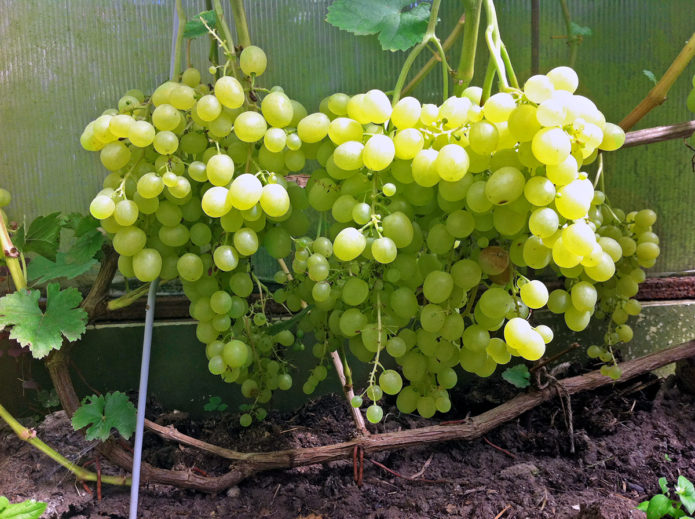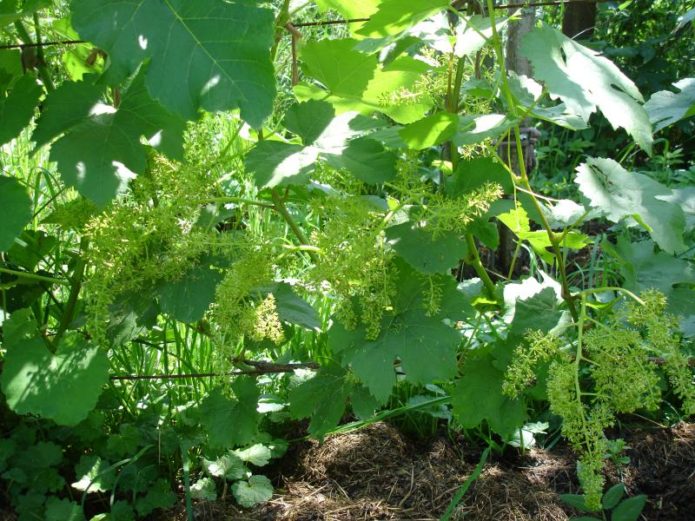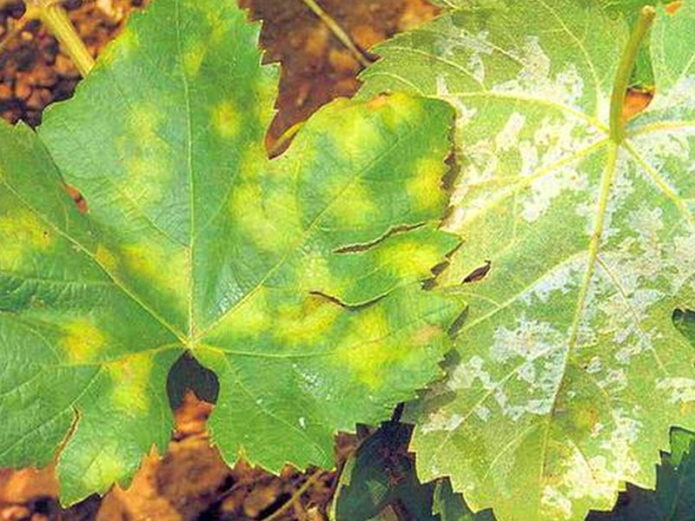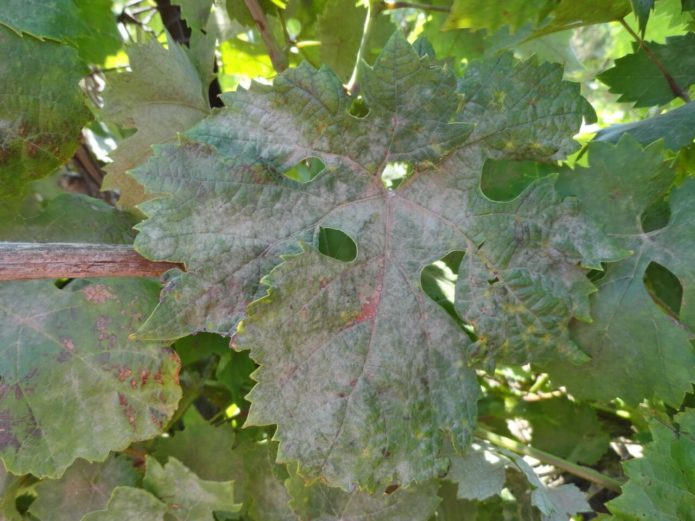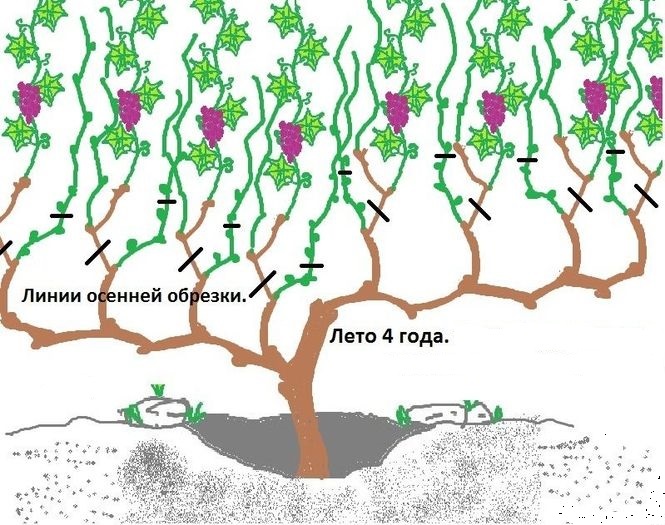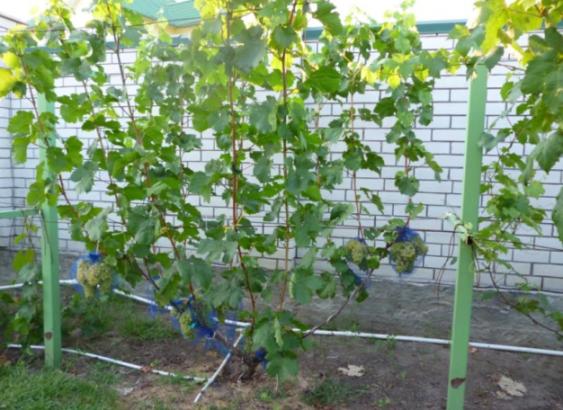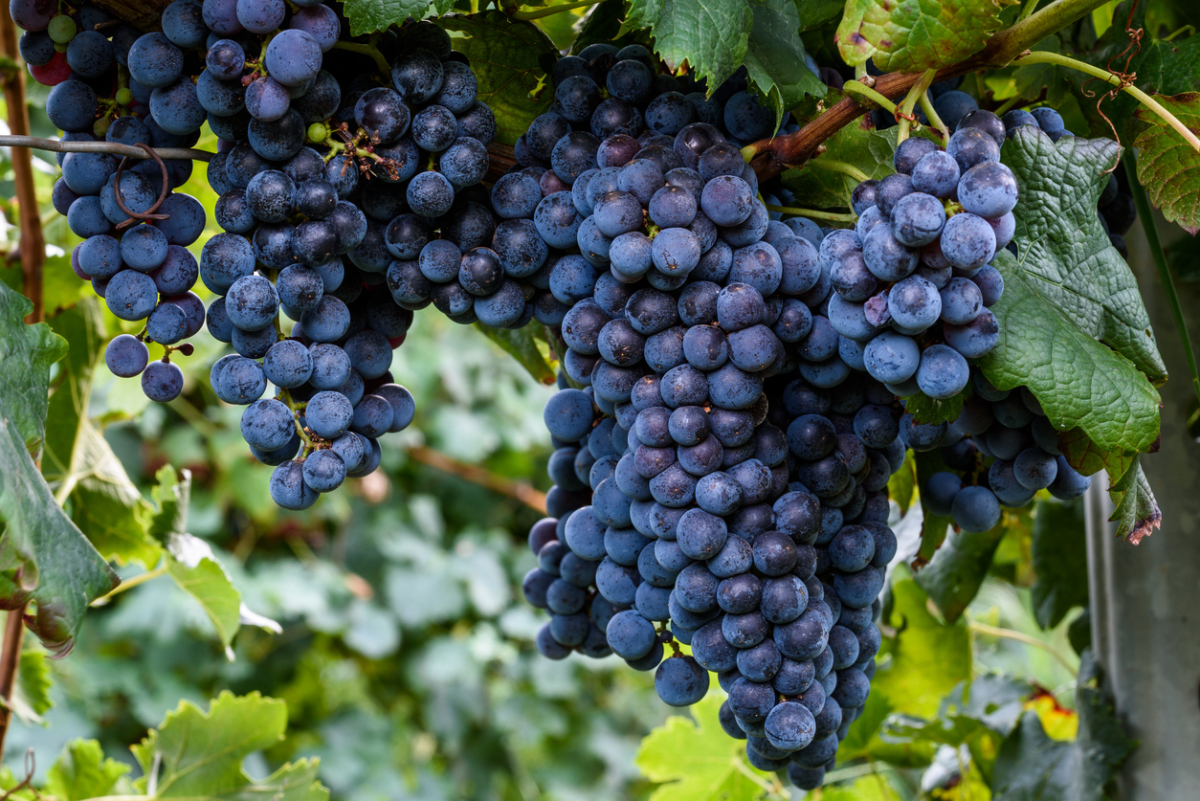Weighty bunches of grapes on trellises near the house are the once unrealizable dream of a northerner summer resident. But what connoisseurs of thermophilic berries do not go to grow the cherished bushes. And after all, their labors are crowned with success. Aleshenkin's early grape variety attracts the eye with its heavy tassels, and sweet berries fill the gardener's heart with pride even in Siberia.
Content
Breeding history
Alyoshenkin's grape is over sixty years old. Created in Volgograd in 1956.
The Soviet agronomist Pyotr Efimovich Tsekhmistrenko created it in 1956. Pyotr Efimovich devoted nearly twenty years to breeding work, interrupting it only in order to go to the front. After the war, he continued to pursue his life's work. An experienced agronomist and talented scientist P.E. Tsekhmistrenko created and described many varieties of apple trees, but Aleshenkin received popular recognition for breeding grapes.
Aleshenkin is still cultivated, despite the abundance of modern, more resistant grape varieties. The secret of the success of this grape is in vitality, early maturity and a delicate nutmeg note of sweet berries.
Description and characteristics of the variety
Alyoshenkin is an early variety. The growing season is slightly less than 120 days. The bush has a powerful growth force. The leaves are green, glossy, five-lobed. The flowers are bisexual. On each fruiting shoot, two inflorescences are usually formed.
The clusters are large, conical in shape. Their weight ranges from 500-1000 g, although sometimes it reaches two kilograms... The berries in the brushes are loosely arranged. Ripening time, depending on the region, falls on the end of July or August. Ripe berries of light amber color, oval, weighing 4.5–5 g. They have a pleasant aroma. The skin is of medium density. The pulp is sweet and juicy. According to the description, about 20–40% of berries do not form seeds. Tasting assessment of fresh berries 8.8 points. Table variety. Harvestable. Resistant to skin cracking. 10-25 kg of berries are collected from one bush with careful care, timely pruning, feeding and watering. Some summer residents, and without making such efforts, get, albeit a modest, but their own harvest. Bunches can remain on the vine until cold weather without loss of quality.
Observations have shown that the underground part of the grapes does not tolerate frosts, while the aboveground part can withstand temperatures below 20-25aboutC. Therefore, it is recommended to plant Aleshenkin on a more frost-resistant stock. However, there is ample evidence that this variety is very plastic and quickly recovers.
Gardeners who have been cultivating Alyoshenkin grapes for a long time note a low resistance to fungal infections.At the same time, they pay attention to the fact that the main peak of diseases falls on the period when the harvest is harvested and the vine is ripe.
How to tie grapes on a trellis, practical advice:https://flowers.bigbadmole.com/en/yagody/vinograd/kak-podvyazyvat-vinograd-vesnoy.html
The main diseases of the variety
In shady places and with waterlogging, grapes can infect fungal diseases: mildew - downy mildew and powdery mildew - powdery mildew. It is necessary to monitor the condition of the leaves in order to quickly remove the affected leaves and shoots.
If the affected area is large, they resort to chemical treatments. Effectively copes with diseases Nitrafen. It must be used strictly according to the instructions, observing personal safety measures, since the agent is quite toxic.
A good effect in early spring is given by preventive spraying with copper-containing preparations: 2% copper sulfate or Bordeaux liquid.
Landing features
Cuttings with an open root system are planted in spring or autumn, container cuttings can be planted throughout the season. In order for the seedlings to take root well, you need to pay attention to the following factors:
- The roots must fill the entire volume of the container. Only in this case, when planting, the earthen clod will not disintegrate, and the seedling, without being stressed or sick, will grow.
- The height of a young shoot should be at least 45 cm.
- You need to wait for the earth to warm up above 18aboutFROM.
- A few days before planting, the seedling begins to be hardened: it is taken out into the air so that it is weathered, and at night it is brought into the room.
For this variety use grape planting scheme 1–1.5 by 2.5 m. A gap of at least a meter is left between the cuttings so that the bushes receive enough light. The distance between the rows is 2.5 m. The most illuminated areas are allocated for grapes, since excess moisture and shade can provoke the development of fungal diseases. In the sun and the sugar content of berries is higher. Aleshenkin is less picky about the composition of the soil, but it is better to drain clay soils, add sand and compost. With stagnant water, the roots of grapes can rot.
The vine has a powerful growth force, the root system develops well, so a large planting hole is prepared:
- Dig a hole 80 cm in diameter and 70 cm deep.
- Crushed limestone is poured at the bottom for drainage. This is not necessary on light lands.
- If the soil is clayey, the clay is removed from the site, and the upper fertile layer, sand and rotted humus are added to the planting hole in a ratio of 1: 1: 1. Wood ash (500 ml per bush) can be added to the soil mixture to feed it with potash fertilizers.
- The stalk together with the container is placed in the soil, lightly tamped it, forming a place for planting a seedling.
- Then they take it out of the pit. The walls of the container are carefully cut with scissors, and the seedling is immersed in the planting hole for the entire length of the stem.
- Pour the rest of the soil mixture so that only a young growth is visible above the ground.
- Tamped and watered with warm water.
Features of growing various types of grapes in the conditions of central Russia:https://flowers.bigbadmole.com/en/yagody/vinograd/vyirashhivanie-vinograda-v-sredney-polose-dlya-nachinayushhih.html
Video: how to plant a grape seedling correctly
Growing and care
Cuttings of this variety take root well. Alyoshenkin grapes can also be cultivated by summer residents without much experience in gardening, if they follow certain conditions. In order for the berries to fully ripen in a short summer and fill with sweet juice, it is necessary to leave only one flowering brush on each fruiting shoot. The lower bunch is usually kept, and the rest are removed without regret. This is a timely rationing of the harvest.
Sometimes not all flowers in an inflorescence are fertilized. Unfertilized flowers do not form full-fledged berries, but give small nondescript berries.This phenomenon is called pea. Peeling is often observed when the weather is cool and rainy during the flowering of the grapes. It is recommended to remove small peas so that the brush is thinned out, better ventilated and illuminated by the sun, which will ultimately have a beneficial effect on the quality of the remaining fruits. Sometimes it is necessary to remove fertilized berries, as otherwise the brush will be too dense and will not pick up the necessary sweetness.
Video: Alexander Mchedlidze on thinning bunches of grapes using the example of the Aleshenkin variety
Watering
Thanks to a strong and branched root system, grapes tolerate a lack of moisture quite well. Close attention and timely watering is required to a greater extent for young cuttings planted in the ground. After planting, in the absence of rain, the bushes are watered with warm water every two weeks, adding up to 40 liters of water under the root of the plants. Depending on the specific weather conditions, the amount of water and the frequency of watering are increased or decreased in order not to let the seedlings die from drought, but also not to lead to decay of the roots.
Adult grape bushes are watered during flowering, as well as when the berries begin to pour. Then watering is stopped so that the bunches pick up sweets. Plants are abundantly watered closer to autumn, in October, when the grapes are preparing for winter.
Pruning
For the prevention of diseases, experienced gardeners recommend paying special attention to normal pruning and bush formation, so that the grapes are thinned and well illuminated by the sun. Very important autumn pruning of grapes. If you do not hold it, but cut the vine in the spring, after the start of sap flow, the vine will run out of juice, and the losses for the plant will be very great. When pruning, be sure to leave the hemp so that the shoot does not dry out.
The grapes are pruned immediately after planting. Only two powerful shoots are left, extending from the cuttings, the rest are removed. During the summer, all stepchildren, shoots growing from the leaf axils, and branches are also cut off. In August, pinch the growth zone to allow the vine to ripen.
Before freezing, a mature vine is shortened to a height of 50 cm, leaving 5–6 buds on each shoot. Each of the main shoots in the spring will need to be fixed horizontally on the trellis, spreading apart like the letter V. From each bud of both shoots, new vertical shoots will go next year - fruiting arrows. But not all of them leave. Only one or two extreme, so as not to thicken the plant too much. This is a fan-shaped way of forming a bush. Such plantings are better illuminated by the sun, the berries are poured and have time to ripen. In the first two or three years, they try not to leave clusters of grapes on the vine in order to allow it to grow stronger. The main fruiting begins at three-year-old Alyoshenkin bushes.
Top dressing
Practical gardeners note that the immunity of grapes is significantly strengthened, and the plant suffers less from diseases if periodically receives additional feeding. The most affordable organic fertilizers - rotted horse manure, mullein, bird droppings, are better absorbed in the form of infusion.
Slurry is prepared by adding water to a container with manure in a ratio of 1: 3. Leave for two to three days, stirring occasionally, until gases begin to evolve. The resulting mixture is decanted, another five to six parts of water are added to the liquid part, stirred and added to the root of each bush in a bucket. When using chicken manure, add two to three times more water.
Weed infusion is even easier to prepare. Collect nettles, comfrey, runny and other herbs, put them in a barrel. Pour in water and leave for several days. When the odor from the barrel becomes pronounced, you can water the plants. In order not to spread weed seeds, herbs are placed in the container before flowering and seed formation.
As soon as the bunches begin to pour, the feeding is stopped. This usually occurs in August.
Connoisseurs of fragrant berries and followers of "green" agriculture prefer not to lean on treatment, but to prevent diseases, strengthening the immunity of plants.
Having planted grapes in the country, you must be prepared for the fact that you will have to take care of it constantly. No, you don't need to be very scared, of course, most of the works are quite accessible to a beginner, but you will need to learn something:https://flowers.bigbadmole.com/en/yagody/vinograd/vinograd-na-dache.html
Shelter for the winter
The grapes are harvested after a stable cold weather is established. This is usually the end of November. The bush is bent down, covered with a fruit box. A sheet of plywood, slate or roofing material is placed on top. They do not cover too tightly from the sides so that the shoots do not burst. If possible, add snow.
Roots require special attention, they are most sensitive to cold weather. To protect them from frost, the grass around the grapes is not weeded out. And if during the summer the weeds were actively removed, you need to rake the fallen leaves around the bush, but not your own, as pathogens of grape diseases can spread, and cover it with spruce branches.
Growing in regions
Thanks to its unpretentiousness, endurance and early ripening of berries, the Alyoshenkin variety has spread far from the Volgograd region, where it was created.
Siberia
The area of distribution of grapes also covers Siberia. Even in the Krasnoyarsk Territory, the Aleshenkin variety is grown. Olga Nikolaevna Khudyakova, one of the initiators of the creation of a winegrowers' club in the village of Shushenskoye, talks about her experience:
- I have been growing grapes for over ten years. During this time, by trial and error, taking into account the experience of the winegrowers of our vast Russia and neighboring countries, she has achieved certain results, the main of which is obtaining a stable and high-quality harvest of sunny berries.
I started with the varieties Aleshenkin, ChBZ, Amursky-2, Tukai, tested in Siberia, acquiring more and more new varieties every year. Today I have more than 20 grape varieties.
Everything is important in growing grapes: water and feed on time, pinch the shoots and stepchildren, cover them in time for the winter and open them from wintering ...
These are the techniques you need to grow a variety anywhere. Only Olga Nikolaevna offers to cover the vine when the autumn frost approaches. And with the establishment of subzero temperatures on top of the shelter, pour a layer of sawdust 10 cm in order to protect it from Siberian frosts.
Nizhny Novgorod Region
Sergey Valerievich Ksenofontov, an experienced gardener, believes that despite the unfavorable climate for the southern culture and the short summer, grapes can be grown in the Nizhny Novgorod region and an excellent harvest can be obtained. During his work, Sergei Valerievich began to use certain techniques that accelerate the growth of the vine, so that it could grow stronger and prepare for winter.
If the weather is favorable in spring, and the soil has warmed up, the rooted cuttings are planted in open ground. Plants, as a rule, undergo stress from being transplanted into the soil, therefore Sergey Valerievich recommends transplanting weak plants into a plastic container of a larger volume, without planting them in the ground, and also leaving them in the air. The soil in the container warms up better, the seedling grows intensively, sometimes outstripping the stronger specimens planted in the ground in development. During the summer, all the seedlings are looked after in the same way, removing stepchildren and forming shoots. Towards the end of summer, plants grown in plastic containers are planted in the ground.A few days before planting, they stop watering so that the earthen lump dries out and it can be planted entirely.
When planting, the stalk is placed at an angle to the surface so that the growth without damage can be bent down for shelter for the winter. With such growth, almost a year is won, since the vine that has grown stronger over the summer is capable of giving the first harvest the next year.
Video: gardener Sergey Valerievich Ksenofontov on growing grapes
Unlike warmer regions, where it is not required to prepare the vine for winter, in the zone of risky farming, grapes are necessarily covered.
Growing in the suburbs
The climate in the Moscow region is characterized by cold winters and short, often rainy, summers. And if the grapes are frost to 25aboutSince it can endure, it is more difficult to survive the spring temperature drops, thaws followed by frosts. A young vine requires special care; they try to cover it in the first few years. Some gardeners near Moscow do not even harbor mature bushes of Aleshenkin grapes.
Since for this variety it is not so much watering that is important as ensuring proper illumination, sunny areas are chosen. As a rule, the soil in the Moscow region is clayey, so that the roots do not rot, it is necessary to provide drainage of the planting pit.
To cultivate grapes in the Moscow region, you need to adhere to all the rules of growing and care in order to get a healthy, early and sweet harvest:
- Do not plant the bushes in the shade, and avoid accidental shading.
- It is better to prune the excess shoot than to expose the plant to the threat of disease.
- Apply a fan-shaped bush formation to make the most of the lighting.
- Monitor the condition of the leaves. When signs of illness appear, remove diseased leaves and shoots and destroy them.
- When covering, do not use polyethylene or other moisture-proof materials so that the bush does not overheat and die.
- The best cover for the vine is snow. If possible, shovel it onto the bush.
Growing up in the Leningrad region
Experienced gardener Sergey Sadov successfully breeds about forty different grape varieties on his plot in the Leningrad Region. He notes that the vine grows better and is less sick when cultivated outdoors, rather than in greenhouses. Aleshenkin takes a worthy place in his collection.
Given the unfavorable weather conditions and their consequences for the grapes, I want to warn everyone who is involved in this culture: it is necessary to remove the shelter from the grapes as early as possible in spring. Last year's early spring led to the fact that, under cover, the grapes woke up ahead of schedule and suffered from frosts in May, which in some places turned out to be very strong.
If the shelter has already been removed from the grapes, and there is a threat of new frosts, it is recommended to treat the bushes with Epin in combination with Cytovite or Ekofus.
Usually, a fan-shaped method of forming a bush in four sleeves is used.
Top tips for growing grapes in the North:
- The clay soil must be drained, and the roots of the grapes rot from waterlogging.
- Do not overload the vine. Standardize the harvest.
- Remove the flower brushes until the bushes are 4 years old for the grapes to mature.
- Remove the bottom row of leaves when the brushes begin to fill. This promotes ventilation and better illumination of the bunches.
- After harvest, shorten the fruiting lashes to five buds.
- Don't be greedy. The fewer brushes on the bush, the better the grapes ripen, and the berries are juicier and sweeter.
Almost all the recommendations for gardeners growing Aleshenkin grapes in the zone of risky farming can be summarized as three:
- Better light, less water.
- Normalize the harvest, do not be greedy.
- Insulate the roots, shorten the tops.
Advantages and disadvantages of the variety
Aleshenkin is an early grape. Ripening of berries occurs within 105-118 days. There are new trendy varieties with an earlier ripening period, but these grapes are time-tested.
Advantages:
- It is prized by gardeners for its plasticity. It can grow in different climatic zones.
- Not too picky about the composition of the soil.
- Convenient to grow. It takes root easily and grows quickly.
- Winter hardy. It recovers well after frostbite.
- Gives beautiful large clusters.
- Harvestable.
- The berries are fragrant, very sweet with reasonable care.
- The bunches are transportable.
- Brushes remain on the vine until cold weather, keeping the taste and presentation.
All this favorably distinguishes Aleshenkin from other varieties and supports the interest of gardeners in him.
Disadvantages:
- If the harvest is not rationed, the clusters do not ripen.
- Peas may develop during flowering due to cool and rainy weather.
- The berries are medium-sized.
- Weak resistance to fungal infections.
But it should be noted that diseases occur after harvest, and this does not affect its quality.
Alyoshenkin grape is considered an unkillable variety. And its advantages far exceed its disadvantages. Therefore, you should not deprive yourself of the pleasure of eating your own fragrant berries for fear of not coping with the capricious vine. In any case, this is not about Alyoshenkin.
Reviews
Good day. Alyoshenka's photo has already been posted on the forum, so I won't repeat myself, look. In size - 28x26, super early (if you don't load it up, ripening begins around July 25), very sweet, market-based. By stability at the Codryanka level. After harvesting, do not clog with chemistry, just remove the damaged leaf (by hand). The berry hangs until the end of September without losing quality. The vine is almost ripe by the 20th of August. The cuttings are rooted 50x50. The seedling should be given 3 years for rooting and growing the vine. For the 4th year the load is minimal. On the 5th year - according to the norm. Pruning into 6 internodes. With good care, the brush gives up to 2 kg. It is frost-hardy (26–27,) under the film, 90% awakens without the ground, and is resistant (sores appear after harvesting). Sugar 22-23 at acidity 4. Narselovskie "bombs" are resting. Compared to Super Extra and Galahad, with the same ripening period, it is slightly inferior in size to the berry, but much sweeter, yellower, more effective. Lark competes, but is inferior in maturity. The nuances of the box.
I, frankly, did not notice any particular pain in him, with 2-3 treatments until August. Later, at the end of August, in rainy weather (up to 2006), the young stepchildren grabbed the mildew, but by this time the vine was brown and the harvest was removed. Yes! Indeed, it is standing normally before harvest without any significant damage. But in the second half of August, when the long rains begin, he starts having problems with mildew. And it is problematic to process because of the later varieties ripening next to it.
I can advise the most widespread grape variety in Bashkortostan - Aleshenkin. The variety is far from fashionable, but classic for our region. For 18 years of observation, the variety ripened annually in any summer. The berries are medium (4–5 grams), but the tasting score is quite high - 8.8 points. I grow grapes without any spring autumn shelters due to lack of time.The third year on my site, located in the lowland, the grapes fall under return spring frosts that fell on May 5-9, after which most of the grape bushes lose shoots that have started to grow, the leaves turn black, new shoots appear a week later, that is, after May 17. Nevertheless, in August, Aleshenkin fully matures. Unkillable variety ...
Good night, summer resident! Aleshenkin is our local grape variety, allocated by Tsekhmistrenko in Volgograd. I think our city can be proud of this. BUT! The variety also has disadvantages - this is the size of the berry, the number of seeds in the berry, and a very high susceptibility to fungal diseases. At the moment, there are much more “problem-free” grape varieties, with higher resistance to diseases and a much shorter ripening period.
Even if experienced gardeners do not consider Alyoshenkin grapes to be a disease-resistant variety, careful care and competent agricultural techniques give a tangible result in the form of luxurious bunches of early juicy berries.
